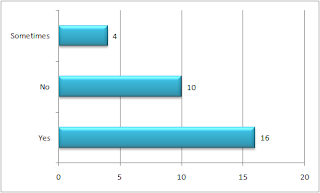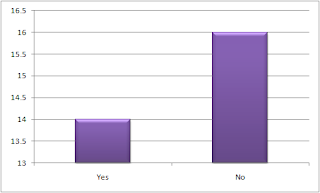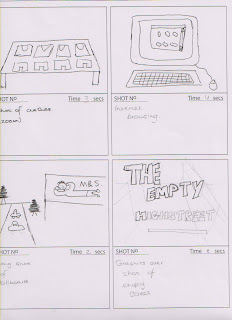Questionnaire - Online Shopping
Please circle where appropriate
1. Are you male or female?
Male Female
2. Do you have a job?
Full-Time Part-Time None
3. Would you rather shop online or on the high street?
Online High Street No preference
4. Do you spend more money on the high street or online?
Online High Street No preference
5. Have you always had success with your purchases online?
Yes No
If not, please explain below.
6. Do you think it is fair that online shopping has more discounts available?
7. Which do you trust more: High Street or Online?
High Street Online No preference
8. What are the “pro's” to you as an individual of shopping online?
9. What are the “cons” to you as an individual of shopping online?
10. Are you an eBay user?
Yes No
11. If yes, have you ever become stressed/anxious over an item you are bidding on? Why?
12. Have you ever regretted buying from an online retailer? If so, why?
13. How did you become involved with online shopping? If you rarely shop online, why have refrained from using online shopping before?
14. On average, how many hours of online shopping do you complete in two weeks (minimum one purchase)?
1-2 3-4 4-5 5-6 6+
15. Have you ever shopped online somewhere but not in store? If so, why?
16. Do you think online shopping has added to or helped the recession? Explain if possible.
17. What is your favourite colour?
18. What is your favourite genre of music?
19. What is your favourite TV channel?
20. When do you tend to watch TV the most?
The Results :-
Q1. Are you male or female?

These results show that the majority of our target audience are female therefore we will make our documentary appeal more to women.
Q2. Do you have a job?

Our results show that the majority of our target audience are full time or part time, therefore we planned to schedule our documentary in the evening for when people would be home to watch it.
Q3. Would you rather shop online or the high street?

This illustrates that our target audience prefer to shop online to the high street, this will be useful to our documentary as it shows how our "lazy generation" would rather go onto the internet than rather buy things in person.
Q4. Do you spend more money on the high street or online?

Our results show that more people spend more online rather on the high street, this could be because of the actual transaction wasn't in person therefore people could "lose track of their money".
Q5. Have you always had success with your purchases?
 It showed that only a small amount of people had a problem with online purchases, when asked why, they answered with a variety of explanations such as incorrect size, the product didn't arrive and the product wasn't what was expected.
It showed that only a small amount of people had a problem with online purchases, when asked why, they answered with a variety of explanations such as incorrect size, the product didn't arrive and the product wasn't what was expected.
Q6. Do you think it is fair that online shopping has more discounts available?

The results explain that over half of the people we questioned think that it's fair that online shopping have discounts, this could probably be because the people who think it is fair are the people that actually online shop whereas the people that think it's unfair are the people who only shop on the high street.
Q7. Which do you trust more: High Street or Online?

This question helped us figure out whether the target audience thought that the online was trustworthy, this shows that even though the majority use online shopping, they would prefer the high street.Q8. What are the Pros of shopping online?

This shows that the main reason that people shop online is because it's quicker than actually going out to buy them. Other pro's were that online shopping is easier with more variety than shops on the high street and a small percentage said that they find that they save more money when shopping online.
Q9. What are the cons of shopping online?

From these results, it shows that there are more cons to online shopping than actual pros. The main reasons behind this is the threat of fraud and the fact that they have to pay delivery charges for their items when they wouldn't have to in the high street.
Q10. Are you an eBay user?

We asked this question as one of the key points of our documentary is about eBay and we wanted to figure out how much of our audience would actually relate to the subject matter.
Q11. If yes, have you ever became stressed/anxious over an item you're bidding on? Why?

This shows that 20 people have became stressed over an item. The reasons for this result was due to - Being outbidded by someone else, they really wanted to the item and they were nervous because they may become sued if they did something wrong.
Q12. Have you ever regretted buying anything from an online retailer? If so, why?

The reasons why people have regretted purchasing an item was because the product didn't turn out what they expected it be, they rarely used it, incorrect description or the item was the wrong size.
Q13. How did you become involved with online shopping?

This shows that mainly people became involved in online shopping due to browsing the internet, this was helpful to our documentary as it showed that people found online shopping by themselves and not influenced by any other factor.
Q14. On average, how many hours of online shopping do you complete in two weeks (minimum one purchase)?

It showed that our target audience spent approximately 3 - 4 hours browsing online, this shows that online browsing is a main usage for accessing the internet.
Q15. Have you ever shopped online somewhere but not in store? If so, why?

The reasons behind them shopping online rather instore was because: - the store was too far away, they simply didn't enjoy high street shopping or they found out that the layout of the store was confusing.
Q16. Do you think online shopping has added to or helped the recession?

They believe that online shopping has added to the trouble of our recession, this could be because the numerous amounts of discounts on offer making people spend more than in person however others believe that it has actually helped, this could be because lack of money spent on transport.Q17. What is your favourite colour?

We asked this question mainly to found out more information on our audience, also the colours could of been chosen as to figure out which graphics we should use, as the favourite colours were pink and blue, we thought that these colours may be too bright and distract the audience so we chose these colours but pastel so it appeals to the audience yet it doesn't take too much focus away.
Q18. What is your favourite genre of music?

We asked them this question so that we could incorporate some of their favourite genres into our documentary, as the majority of the audience has chosen pop, we have decided to place this type of music into our documentary to keep the audiences attention.
Q19. What is your favourite TV Channel?

This shows that the audiences favourite channel consist of none of the terrestial channels however one of the main channels which said to be their favourite was E4 and as E4 is run by Channel four, we decided to schedule our documentary on channel four to gain a higher success rate.
Q20. When do you tend to watch TV the most?

This shows that the most common answer for the question was they watched TV between the hours of 19:00 - 21:00, this is why we decided to slot our documentary at 7pm.






































